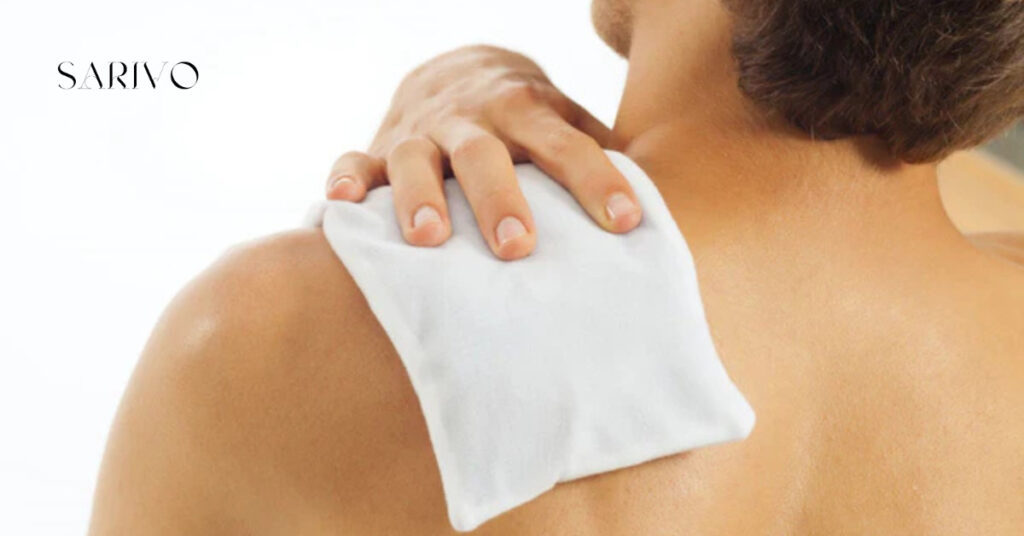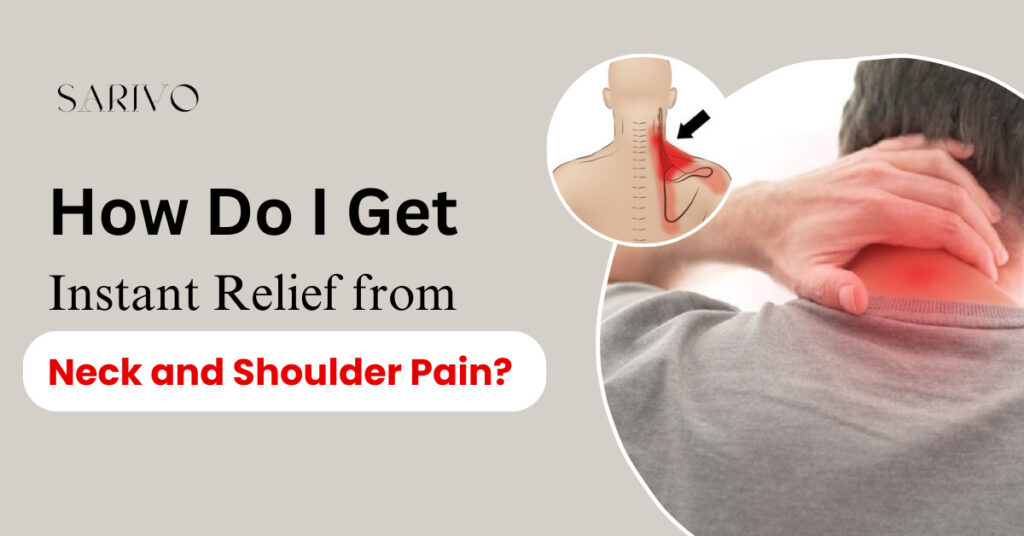Use ice or heat therapy and perform gentle stretching exercises to get instant relief from neck and shoulder pain. Over-the-counter pain relievers can also help.
Neck and shoulder pain can disrupt daily activities and reduce your quality of life. Quick and effective remedies are essential for immediate relief and long-term comfort. Ice packs can reduce inflammation and numb the pain, while heat therapy can relax tight muscles.
Gentle stretching exercises enhance flexibility and reduce tension in the affected areas. Over-the-counter pain relievers like ibuprofen can offer additional relief. It’s crucial to address the root cause of the pain, whether it’s poor posture, stress, or an injury. Consult a healthcare professional for a comprehensive treatment plan if the pain persists. Regular exercises and ergonomic adjustments can prevent recurrence.
Common Causes
Neck and shoulder pain can be very uncomfortable. Many people experience this pain at some point. There are different reasons why this pain happens. It is important to know these reasons. This can help you get relief quickly. Here are some common causes and ways to get instant relief from neck and shoulder pain.
Pillow
Neck and shoulder pain caused by a pillow can often be addressed by considering a few key factors:
- Pillow Height and Firmness: Ensure your pillow provides proper support. A pillow that’s too high or too firm can misalign your neck and shoulders. If you sleep on your side, a firmer and higher pillow is usually better, while back sleepers may need a thinner pillow.
- Material: Memory foam or latex pillows can provide better support by contouring to the shape of your head and neck. Avoid overly soft pillows that don’t provide adequate support.
- Sleeping Position: Your sleeping position affects pillow choice. Side sleepers need more elevation, while back sleepers benefit from a medium height. Stomach sleeping is generally discouraged, as it can strain the neck.
- Pillow Replacement: Pillows lose their shape and support over time. Consider replacing your pillow every 1-2 years to ensure proper support.
- Adjusting Pillow Placement: Sometimes, simply adjusting how you position your pillow can help. For example, placing a small pillow under your neck can provide additional support.
Poor Posture
Poor posture is a major cause of neck and shoulder pain. People often slouch or hunch over. This puts extra strain on the neck and shoulders. Here are some ways to improve your posture:
- Sit up straight while using a computer or phone.
- Keep your feet flat on the floor.
- Use a chair with good back support.
- Take breaks to stand and stretch.
Another tip is to adjust your screen height. Make sure the top of the screen is at eye level. This helps keep your neck in a natural position. Also, consider using a standing desk. This can reduce the time spent sitting. Good posture can prevent a lot of neck and shoulder pain.
Stress And Tension
Stress and tension can also cause neck and shoulder pain. People often tense their muscles when they are stressed. This can lead to pain and discomfort. Here are some tips to reduce stress and tension:
- Practice deep breathing exercises.
- Take short walks to clear your mind.
- Try yoga or stretching exercises.
- Listen to calming music.
Massage can also help relieve tension. You can use a foam roller or a tennis ball to massage sore areas. Gentle neck stretches can also help. Tilt your head to one side and hold for 15 seconds. Then switch to the other side. Repeat this a few times to ease muscle tension.
Quick Stretching Techniques

Neck and shoulder pain can be very annoying. It can make it hard to work or relax. Quick stretching techniques can help. These stretches can give you instant relief. They are easy and can be done anywhere. Try these stretches to feel better fast.
Neck Rolls
Neck rolls are great for relieving neck pain. They are simple to do and very effective. Follow these steps for a great stretch:
- Sit or stand up straight.
- Relax your shoulders.
- Slowly drop your chin to your chest.
- Roll your head to the right side.
- Hold for a few seconds.
- Continue to roll your head back.
- Bring your head to the left side.
- Hold for a few seconds.
- Complete the roll by bringing your head back to the front.
Repeat this roll a few times. Always move slowly and gently. This will help avoid any strain. Neck rolls can reduce tension and improve flexibility. This stretch can be done anytime you feel stiff.
Shoulder Shrugs
Shoulder shrugs are another great way to ease shoulder pain. They are very easy and quick. Here is how you do them:
- Stand or sit up straight.
- Relax your arms by your sides.
- Lift your shoulders up towards your ears.
- Hold this position for a few seconds.
- Slowly lower your shoulders back down.
- Repeat this movement several times.
Shoulder shrugs help to relieve tension in the shoulders. They also improve blood flow to the area. This can reduce pain and stiffness. You can do shoulder shrugs at your desk or while watching TV. They are a quick and effective way to feel better.
Heat Therapy
Neck and shoulder pain can be debilitating. This pain often arises from poor posture, stress, or injuries. Heat therapy is a simple and effective way to get instant relief. Applying heat to the affected areas can relax muscles, improve blood flow, and ease stiffness. This blog post explores two popular heat therapy methods: heating pads and warm compresses.
Heating Pads
Heating pads are a popular choice for relieving neck and shoulder pain. They come in various types, such as electric, microwaveable, and chemical pads. Electric heating pads provide consistent heat and allow you to control the temperature. Microwaveable pads are filled with materials like rice or flaxseed. You heat them in the microwave for a few minutes before use. Chemical heating pads activate and heat up when you break a small metal disk inside the pad.
Using a heating pad is simple:
- Place the heating pad on your neck or shoulder.
- Set the temperature to a comfortable level.
- Leave it on for 15-20 minutes.
- Remove the pad and let your skin cool down.
Benefits of heating pads include:
- Quick and easy to use.
- Portable and convenient.
- Effective in soothing sore muscles.
Precautions:
- Do not use it for more than 20 minutes at a time.
- Never use a heating pad while sleeping.
- Check your skin frequently to avoid burns.
Warm Compresses
Warm compresses are another effective way to relieve neck and shoulder pain. They work by applying moist heat, which penetrates deeper into the tissues. You can make a warm compress at home using a towel and warm water. This method is especially useful for targeted pain relief.
Steps to make a warm compress:
- Soak a clean towel in warm water.
- Wring out the excess water.
- Fold the towel and place it on the painful area.
- Leave it on for 15-20 minutes.
Benefits of warm compresses include:
- Easy to prepare at home.
- Provides deep tissue relief.
- Moist heat is more soothing than dry heat.
Precautions:
- Ensure the water is not too hot.
- Check your skin for any adverse reactions.
- Do not use if you have open wounds.
Both heating pads and warm compresses are effective methods for instant pain relief. They can help you manage neck and shoulder pain quickly and easily.
Cold Therapy

Neck and shoulder pain can be very annoying and painful. Getting quick relief is important. Cold therapy is one of the best ways to reduce pain and inflammation. It can help numb the area and reduce swelling. Let’s explore how ice packs and cold compresses can help you feel better quickly.
Ice Packs
Ice packs are very effective for neck and shoulder pain. They can help reduce inflammation and numb the painful area. You can buy ice packs from a store or make one at home. Here are some simple steps to use ice packs effectively:
- Wrap the ice pack in a thin towel.
- Place it on the painful area for 15-20 minutes.
- Take a break for at least 1 hour before reapplying.
Remember to never place ice directly on your skin. This can cause ice burns. Using ice packs correctly can provide instant relief. They are a great way to manage pain without medication. For best results, use ice packs several times a day.
Cold Compresses
Cold compresses can also help with neck and shoulder pain. They are easy to make and use. Cold compresses can be made with a cloth soaked in cold water. Follow these steps to use a cold compress:
- Soak a clean cloth in cold water.
- Wring out the excess water.
- Place the cloth on the painful area for 15-20 minutes.
- Re-soak the cloth in cold water if it gets warm.
Cold compresses can be very soothing. They help to reduce swelling and pain. Using cold compresses regularly can help you manage pain effectively. They are a simple and natural way to find relief.
Massage Benefits
Neck and shoulder pain can be a real hassle. Many people face this issue due to poor posture, stress, or long hours at a desk. One effective solution is massage. Massage offers numerous benefits, such as reducing tension and improving blood flow. Both self-massage and professional massage can provide instant relief. Let’s explore these techniques in detail.
Self-massage Techniques
Self-massage is a great way to relieve neck and shoulder pain quickly. First, find a comfortable spot to sit or lie down. Use your fingers to gently press on the sore areas. Apply steady pressure and make small, circular motions.
Here are some simple steps to follow:
- Place your hand on the back of your neck.
- Press gently and move your fingers in circles.
- Repeat this on your shoulders.
- Use both hands for better results.
Another effective method is using a tennis ball. Place the ball between your back and a wall. Lean into the ball and move your body to massage the sore spots. This can help release muscle knots and reduce pain.
Self-massage is convenient and can be done anytime, anywhere. It helps to relax muscles and improve blood flow. Regular self-massage can prevent future pain and keep your neck and shoulders healthy.
Professional Massage
Professional massage offers deeper relief for neck and shoulder pain. Trained therapists use various techniques to target specific muscle groups. This can provide more effective and lasting results.
Common types of professional massages include:
| Massage Type | Description |
| Swedish Massage | Uses long strokes and kneading. Helps to relax the whole body. |
| Deep Tissue Massage | Focuses on deeper muscle layers. Ideal for chronic pain and tension. |
| Trigger Point Massage | Targets specific pain points. Relieves tight muscles and knots. |
Professional massage offers a tailored approach to pain relief. Therapists can adjust techniques based on your needs. This ensures you get the most benefit from the session.
Booking regular sessions can help maintain muscle health. It also reduces the risk of recurring pain. Always consult a healthcare provider before starting any new treatment.
Mindfulness Practices
Neck and shoulder pain can be a real bother. It can make simple tasks hard. Mindfulness practices can help. These practices bring relief quickly. They focus on the mind and body. Here are some effective methods.
Deep Breathing
Deep breathing is a great way to ease pain. It helps relax tight muscles. This makes the pain less intense. You can do it anywhere, anytime.
Follow these steps:
- Sit or lie down in a comfy spot.
- Close your eyes to focus better.
- Take a slow, deep breath in through your nose.
- Let your belly rise as you breathe in.
- Hold your breath for a few seconds.
- Slowly breathe out through your mouth.
- Let your belly fall as you breathe out.
Repeat these steps several times. Feel the tension melt away. Deep breathing calms your mind too. This makes it easier to handle pain.
Meditation
Meditation is another helpful practice. It trains your mind to focus. This helps in reducing pain. Meditation can be done in different ways.
Try this simple method:
- Find a quiet place.
- Sit comfortably with your back straight.
- Close your eyes and relax your body.
- Focus on your breath. Notice how it feels.
- When your mind wanders, gently bring it back to your breath.
Do this for a few minutes each day. Over time, it gets easier. Meditation reduces stress too. This can make neck and shoulder pain less severe.
Hydration Importance
Neck and shoulder pain can be very uncomfortable. Quick relief is often necessary. One simple way to ease the pain is by staying hydrated. Hydration plays a key role in muscle health. It helps in reducing inflammation and stiffness. Let’s dive into how water intake and electrolyte balance can help.
Water Intake
Drinking enough water can significantly reduce neck and shoulder pain. Water helps keep muscles hydrated and flexible. Dehydrated muscles tend to cramp and ache more.
Here are some simple ways to ensure you drink enough water:
- Carry a water bottle with you.
- Set reminders to drink water.
- Drink a glass of water before each meal.
Water also helps in flushing out toxins. These toxins can build up in muscles and cause pain. Aim to drink at least 8 glasses of water a day. This will keep your muscles happy and pain-free.
Electrolyte Balance
Electrolytes are important for muscle function. They help in muscle contraction and relaxation. An imbalance can lead to muscle cramps and pain.
Here are some key electrolytes and their sources:
| Electrolyte | Food Source |
| Sodium | Salt, pickles |
| Potassium | Bananas, potatoes |
| Magnesium | Nuts, spinach |
| Calcium | Milk, cheese |
Maintaining a good electrolyte balance can prevent muscle pain. Make sure to include these foods in your diet. You can also opt for electrolyte drinks. These can quickly restore balance and relieve pain.
Ergonomic Adjustments
Neck and shoulder pain can be very annoying. It can make daily tasks hard. One way to help is through ergonomic adjustments. These changes can make your workspace better. They can reduce strain and pain. By making small changes, you can feel a lot better.
Desk Setup
Your desk setup is very important. It can help reduce neck and shoulder pain. Here are some tips for a good desk setup:
- Make sure your computer screen is at eye level. This helps keep your neck straight.
- Keep your keyboard and mouse close. Your elbows should be at your sides.
- Use a standing desk if possible. This can help change your posture during the day.
- Keep items you use often within easy reach. This stops you from stretching too much.
A good desk setup can make a big difference. It can help you feel better quickly. Try these tips to see if they help you.
Chair Support

A good chair is also very important. It can help support your back, neck, and shoulders. Here are some tips for choosing a good chair:
- Choose a chair with good lumbar support. This helps support your lower back.
- Make sure the chair height is adjustable. Your feet should be flat on the ground.
- Use a pillow or cushion for extra support if needed.
- A chair with armrests can help support your arms and reduce shoulder strain.
A good chair can make a big difference. It can help you feel better and be more comfortable. Try these tips and see if they help reduce your pain.
When To Seek Help
Neck and shoulder pain can be very annoying. It can stop you from doing many things. Sometimes, this pain needs quick relief. Knowing when to seek help is very important. This blog will guide you on that.
Persistent Pain
Persistent pain is pain that does not go away. It lasts for a long time. This type of pain needs special attention. Ignoring persistent pain can make things worse.
Here are some signs that your pain is persistent:
- Pain that lasts for more than a week
- Pain that does not improve with rest
- Pain that comes back often
If you feel this kind of pain, visit a doctor. They can help find the cause. They can also suggest treatments. Do not try to treat persistent pain on your own. It is always best to get help from a professional.
Symptoms To Watch
Some symptoms need quick attention. These symptoms can be signs of a bigger problem. Knowing these symptoms can help you decide when to seek help.
Here are some symptoms to watch:
- Severe pain that comes suddenly
- Pain that spreads to your arms
- Numbness or weakness in your arms
- Headache along with neck pain
If you have these symptoms, see a doctor right away. They can check if there is a serious issue. Early help can prevent more problems. Always listen to your body and act fast when needed.
Conclusion
Finding instant relief from neck and shoulder pain is possible with the right techniques. Regular stretching, proper posture, and effective pain relief methods can help. Implement these tips to reduce discomfort and improve your quality of life. Prioritize self-care to maintain a pain-free neck and shoulders.

